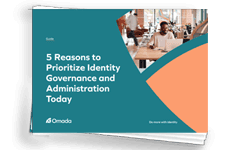Let's Get
Started
Let us show you how Omada can enable your business.
• Full-featured IGA
• Configurability without code
• Best-practice framework for solution design and deployment
• High degree of configurability
• Intelligent compliance
• Manage identities and access across hybrid platforms
• Support at every step of your IGA journey
• Personalized service package to accelerate your deployment
• Avoid common pitfalls and get value in 12 weeks
• Iterative implementation roadmap
• Standardized, well-documented best practices
• Support from Omada-certified project managers, architects, and consultants
• Stellar Customer Success Team
• Quick and professional Service Desk
• Access to ITSM system and KPI reports
• Digital self-paced and instructor-led courses
• Training on demand through our Premier Academy subscription
• Individual, role-based learning plans and certification paths
• Ensure fast and successful IGA deployment
• 5-step process with clear exit criteria
• 12 weeks time to value
• Helps support enterprise IT security
• Makes it easier to meet compliance mandates
• Automates access provisioning and enables the workforce from day 1
• Automated access provisioning and deprovisioning
• Least privilege and separation of duties policies
• Simple-to-run certification campaigns
• Access compliance status dashboards
• Cross-system certification campaigns
• 50+ audit report templates
• Identity lifecycle management
• Automatic access provisioning
• Self-service access requests
Omada provides Governance for Identity Fabric ensuring compliance regulations are met, security and efficiency around identity workflows are maintained.

A definite guide to Identity Governance and
Administration best practices. Learn how to
successfully deploy and maintain an IGA solution.

Our comprehensive Identity and Cybersecurity
glossary, featuring extensive explanations, real-life
examples, practical frameworks and everything else
you need to understand key concepts in identity and
cybersecurity.

In this Guide, Gartner has identified Omada as a
Representative Vendor in IGA. Use it to evaluate top
Identity Governance vendors and anticipate future
trends, features, and capabilities in the IGA market.

Familiarize yourself with the typical threats that
can derail a seamless legacy to cloud migration of
IGA functionality and get tips on managing them.

As part of their digital transformation, DEKRA moved
from an in-house access management solution to
a modern, cloud based Omada IGA solution.

Get practical examples and data proving the
value of IGA and learn the five key reasons you
must make it a business imperative today.

Explore our white papers on compliance, security, and
efficiency topics. Gain insights and best practices to drive
informed decisions and enhance your organizational strategy.

We are constantly adding new features to Omada
products to ensure your IGA efforts keep pace with
the ever-evolving threat landscape.

Get information about the newest Omada product
features, benefits, and use cases to ensure you get
the most from your IGA program.

Participate in interactive product demos covering
capabilities such as Delegate Access, Request
Access, Approve Access Request, and more.

Get the latest IGA trends, information, and intelligence
from renowned industry experts in Omada’s live and
on-demand webinar presentations.

A market-leading provider of identity governance
and administration solutions. Get to know us better!

At Omada, efficient teamwork creates extraordinary results.
We enable talented people to create career paths where
they can thrive, be inspired, and have fun.

Omada partners provide unmatched advisory, product
and service re-sale, and project delivery resulting in
unsurpassed customer satisfaction scores.

Don’t just take our word about the value of Omada
solutions. See what actual users think.

See what the media are reporting about our
innovative identity governance solutions.

We frequently deliver expert presentations, exhibit, and
run demos at the world’s leading security and IGA events.
Look at our upcoming schedule to see if we cross paths –
we'd love to speak with you.

Omada is a winner for a third consecutive year in the 7th
annual CyberSecurity Breakthrough Awards program.

Omada is a global market leader in Identity Governance.
Please reach out to us with questions or to get more information.

Find here legal documents governing and relating to the
provisioning of Omada Offerings - Customer Agreement, DPA, and more.
• Full-featured IGA
• Configurability without code
• Best-practice framework for solution design and deployment
• High degree of configurability
• Intelligent compliance
• Manage identities and access across hybrid platforms
• Support at every step of your IGA journey
• Personalized service package to accelerate your deployment
• Avoid common pitfalls and get value in 12 weeks
• Iterative implementation roadmap
• Standardized, well-documented best practices
• Support from Omada-certified project managers, architects, and consultants
• Stellar Customer Success Team
• Quick and professional Service Desk
• Access to ITSM system and KPI reports
• Digital self-paced and instructor-led courses
• Training on demand through our Premier Academy subscription
• Individual, role-based learning plans and certification paths
• Ensure fast and successful IGA deployment
• 5-step process with clear exit criteria
• 12 weeks time to value
• Helps support enterprise IT security
• Makes it easier to meet compliance mandates
• Automates access provisioning and enables the workforce from day 1
• Automated access provisioning and deprovisioning
• Least privilege and separation of duties policies
• Simple-to-run certification campaigns
• Access compliance status dashboards
• Cross-system certification campaigns
• 50+ audit report templates
• Identity lifecycle management
• Automatic access provisioning
• Self-service access requests
Omada provides Governance for Identity Fabric ensuring compliance regulations are met, security and efficiency around identity workflows are maintained.

A definite guide to Identity Governance and
Administration best practices. Learn how to
successfully deploy and maintain an IGA solution.

Our comprehensive Identity and Cybersecurity
glossary, featuring extensive explanations, real-life
examples, practical frameworks and everything else
you need to understand key concepts in identity and
cybersecurity.

In this Guide, Gartner has identified Omada as a
Representative Vendor in IGA. Use it to evaluate top
Identity Governance vendors and anticipate future
trends, features, and capabilities in the IGA market.

Familiarize yourself with the typical threats that
can derail a seamless legacy to cloud migration of
IGA functionality and get tips on managing them.

As part of their digital transformation, DEKRA moved
from an in-house access management solution to
a modern, cloud based Omada IGA solution.

Get practical examples and data proving the
value of IGA and learn the five key reasons you
must make it a business imperative today.

Explore our white papers on compliance, security, and
efficiency topics. Gain insights and best practices to drive
informed decisions and enhance your organizational strategy.

We are constantly adding new features to Omada
products to ensure your IGA efforts keep pace with
the ever-evolving threat landscape.

Get information about the newest Omada product
features, benefits, and use cases to ensure you get
the most from your IGA program.

Participate in interactive product demos covering
capabilities such as Delegate Access, Request
Access, Approve Access Request, and more.

Get the latest IGA trends, information, and intelligence
from renowned industry experts in Omada’s live and
on-demand webinar presentations.

A market-leading provider of identity governance
and administration solutions. Get to know us better!

At Omada, efficient teamwork creates extraordinary results.
We enable talented people to create career paths where
they can thrive, be inspired, and have fun.

Omada partners provide unmatched advisory, product
and service re-sale, and project delivery resulting in
unsurpassed customer satisfaction scores.

Don’t just take our word about the value of Omada
solutions. See what actual users think.

See what the media are reporting about our
innovative identity governance solutions.

We frequently deliver expert presentations, exhibit, and
run demos at the world’s leading security and IGA events.
Look at our upcoming schedule to see if we cross paths –
we'd love to speak with you.

Omada is a winner for a third consecutive year in the 7th
annual CyberSecurity Breakthrough Awards program.

Omada is a global market leader in Identity Governance.
Please reach out to us with questions or to get more information.

Find here legal documents governing and relating to the
provisioning of Omada Offerings - Customer Agreement, DPA, and more.
Home / What is an Emergency Lockout?


An Emergency Lockout is an action that an organization takes during a cyberattack or when a significant data breach in an IT infrastructure has been detected. In an Emergency Lockout, an organization deliberately restricts or blocks access to certain systems, accounts, or data either as a precautionary measure to prevent further damage, contain the attack, or stop attackers from gaining further control over critical systems.
If an organization is hit by ransomware, an Emergency Lockout might be triggered to prevent the spread of the malicious software across the network.
If there’s a suspicion that an attacker has gained unauthorized access to a user account, an Emergency Lockout could be used to suspend or lock the account until the threat is addressed.
In cases of a breach or intrusion, an Emergency Lockout may prevent attackers from continuing to move through the system, gaining access to more sensitive data or administrative privileges.
Specific actions organizations typically take as part of an Emergency Lockout include:
Devices that could be disconnected include computers, servers, and even mobile devices. This isoIates compromised systems by disconnecting them from the organization’s network to prevent the attack from If an organization suspect ransomware or malware, they should immediately unplug the device and disable Wi-Fi or other connections.
As part of an Emergency Lockout plan, organizations should take steps to avoid deleting files or making changes to affected systems. Instead, they document the attack by taking screenshots, saving error messages, and logging unusual activity. Preserving this evidence is essential for forensic investigations, identifying the source of the breach, and potentially pursuing legal action.
Organizations inform employees, contractors, partners, vendors, and customers about the Emergency Lockout. Clear, transparent communication is crucial to prevent panic and ensure everyone knows how to respond.
Other systemic actions include taking back-up servers offline, powering the domain controller off, and changing network shares to read-only.
Malicious actors design passive attacks to include a persistent backdoor into an organization’s IT infrastructure, so they can continue to exfiltrate sensitive data over time. It’s important to identify and shut down all access the attackers may have to your system. This is also true for an active attack. In all cases, it is critical to totally deny the attackers access to your system.
Once an attack has been contained, organizations must determine which (if any) critical business functions have been compromised, what data has been affected by the breach, which systems have been subjected to unauthorized access, and whether any unauthorized entry points remain. Systems may need to be reinstalled, compromised data may need to be restored from backup copies, and any damaged hardware repaired or replaced.
As soon as the immediate threat is neutralized, IT teams and users must update passwords for all systems, devices, and accounts. Use strong, unique passwords and implement multi-factor authentication (MFA) to ensure that hackers cannot re-enter your systems using previously compromised credentials.
Appoint a Cyber Incident Owner and keep an action log, decision log and priority list for protection and recovery during the whole incident. You should record the times that commands were run, and what activities were undertaken.
The purpose of compliance rules is to help organizations safely minimize the damage of a security incident and process lessons learned to prevent similar attacks in the future. Be truthful and honest, accurate and realistic.
By proactively implementing robust security measures, organizations can significantly reduce the risk of a data breach and avoid having to implement an Emergency Lockout. Learn more.



